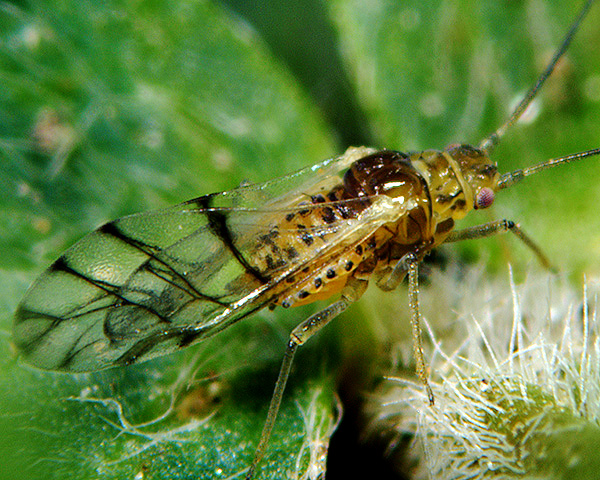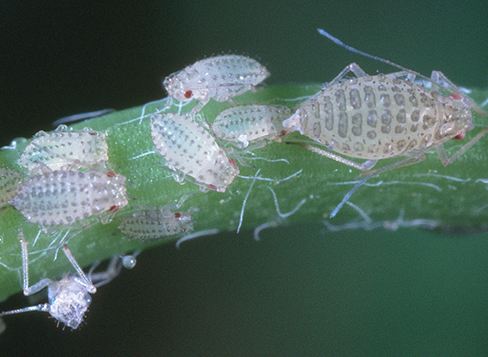Spotted Alfalfa Aphid
Therioaphis trifolii (=Therioaphis maculata)
The spotted alfalfa aphid, was accidentally introduced into central New Mexico in 1954 and quickly spread throughout the alfalfa-growing areas of the United States.
|
Closeup of adult spotted alfalfa aphid. |
Winged adults and nymphs. |
Description
They are pale yellowish in color with rows of black spots on their backs, each tipped with a short spine. The winged form (alate) has smokey-colored areas along the wing veins. Mature aphids are only about 1/16 inch-long; spots may be difficult to see without magnification on small nymphs.
Life History
Wingless parthenogenetic females (apterae) can each give birth to 100 or more live young without mating, the offspring passing through four instars in as little as five days in warm weather. The entire life cycle may be completed in less than seven days. In the fall, males and sexual females (oviparae) are produced and the latter lay eggs that overwinter in the crop.
Damage
Although spotted alfalfa aphids prefer alfalfa, they will also infest some clovers. They inject toxic salivary secretions into the plants as they feed, causing yellowing of the leaf at the feeding site and along the veins. In general, spotted alfalfa aphids are found on the underside of lower leaves, but they will move up higher on the plant as the lower leaves are killed. Uncontrolled populations can destroy new stands and reduce yield and protein content by half on established stands. Secreted honeydew fosters the growth of sooty mold that reduces hay quality and makes harvesting difficult. Seedlings of susceptible varieties may be damaged by little more than one aphid per plant, but many modern varieties varieties express resistance to spotted alfalfa aphid and suffer less damage.
Scouting
Pick complete stems at random in several parts of the field and count the number of spotted alfalfa aphids per stem. Carefully sample at least 20 to 30 stems at each location, being aware that the aphids drop easily from the stem as it is removed. Measure the length of each stem and calculate the average number of aphids per stem and average stem length. Watch for foraging lady beetles and make note of mummified aphids (brown and swollen) as these are parasitized and should not be included in the count. If mummies and lady beetles are abundant, the population may be coming under natural biological control. Insecticides should be applied to seedling stands when two to three healthy aphids per seedling are present. Plants two to three inches tall can tolerate four to five aphids per plant. Use at least 12 gallons of water per acre and apply when daytime temperatures are expected to be above 65 °F. In established alfalfa, higher populations are required to justify treatment. On 10 inch tall alfalfa, treatment is generally required when 50+ aphids per stem are present, and for 20 inch tall alfalfa, 100+ aphids per stem are needed. Data on the efficacy of insecticides against spotted alfalfa aphid in Kansas is limited. The use of resistant varieties is often the only way to establish a stand under drought conditions when spotted alfalfa aphids are present.
Please refer to the most recent Alfalfa Insect Management Guide for specific control options.
Page last updated 4/17/2024 by J.P. Michaud.

